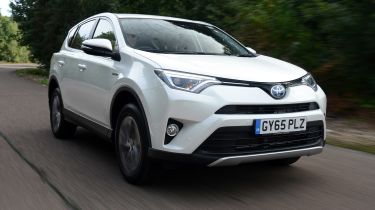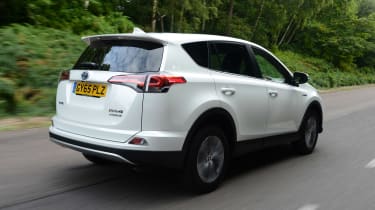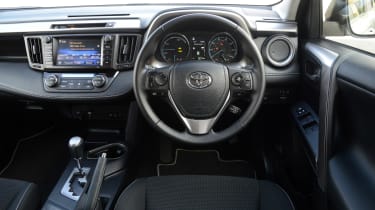Toyota RAV4 Hybrid 2WD 2016 review
Does losing two driven wheels make the RAV4 Hybrid a more accomplished car? We drive it to find out
The Toyota RAV4 Hybrid serves to accommodate buyers who’ve been put off diesel but require an SUV with a proven, reliable powertrain. It’s a shame then, that in most other respects the Toyota is thoroughly outclassed by plug-in or oil-burning alternatives. In terms of ride and handling, performance, design and even efficiency, the petrol-electric RAV4 just isn’t competitive enough for a company that usually takes its hybrid models so seriously.
It’s almost a surprise that Toyota left it so late to introduce a hybrid version of its RAV4, especially given the brand’s long history with electrically assisted powertrains. A few years ago a RAV4 hybrid would have had the market to itself. Now, though, there’s a sprinkling of cleverer plug-in hybrid SUVs arriving on the scene, offering impressive claimed efficiency figures and useful electric-only range.
We’ve already tried Toyota’s four-wheel drive RAV4 Hybrid earlier this year, but given the aim of this SUV is to be as frugal as possible – and most RAV4 owners are unlikely to venture near a rutted track that often - it’s the two-wheel drive version that looks more relevant. At least, that’s the theory.
In most SUVs, losing the mechanical bits that power the extra set of wheels in the four-wheel drive version brings significant economy benefits. The RAV4 Hybrid is different, however, because Toyota uses electric motors mounted on the rear axle instead of the usual driveshaft to power the rear wheels in the 4x4 model. That means economy is improved only slightly on the 2WD model without those motors: 55.4mpg becomes 57.6mpg, and 118g/km of CO2 turns into 115g/km. It’s hardly deal-breaking stuff.
More reviews
Car group tests
In-depth reviews
Long-term tests
Road tests
Used car tests
Performance from the 2.5-litre petrol engine, mated to a CVT gearbox and a battery using rather old nickel-metal hydride technology, is identical whichever model you choose. Don’t be fooled by a sprightly sounding 0-62mph time of 8.4 seconds, however. In reality, despite decent performance around town thanks to the electric assistance, the RAV4 Hybrid doesn’t feel anywhere near as fast as the figures suggest, particularly when it’s tasked with keeping up the pace on the motorway.
Deploy anything more than part-throttle and, as is usually the way with CVT transmissions, the engine revs soar uncomfortably high with not that much gain in forward momentum.
• Best 4x4s and SUVs on the market
Toyota is claiming that the latest RAV4 is more refined than before thanks to powertrain and sound insulation improvements, but this hybrid doesn’t isolate either engine noise or low-speed electric motor whine as well as the new Prius. It does settle down to a refined cruise once you’re up to speed, but the next time you find yourself going up a hill or pulling away from a junction the irksome drone returns.
Of course, few people will buy a hybrid with the intention of thrashing it around, and the RAV4 Hybrid’s vague steering, inconsistent brakes and near 1.8-tonne kerbweight quickly put pay to any driving fun. At least the powertrain seamlessly switches between electric and petrol power, operating solely in EV mode up to 40mph for around a mile – although any plug-in SUV will better that range considerably.
• Toyota RAV4 Hybrid 4WD review
Over a mixed driving route we found around 40mpg to be the norm, which is acceptable but no better than the diesel. The ride also disappoints, with large potholes thumping and crashing into the cabin around town more when compared with the regular diesel RAV4.
There are some positives, though. The 2WD RAV4 Hybrid is only available in entry-level Business Edition Plus spec, making it considerably cheaper than the 4WD Excel we previously tested. That’s despite it coming as standard with kit such as sat-nav, LED headlights, an electric tailgate and keyless entry and start.
It loses a bit of bootspace due to the battery pack (547 litres plays 501 litres), but in all other respects the interior remains a spacious, if bland, place to spend time. Towing capacity is greatly reduced, however; the AWD hybrid can pull up to 1,650kg, while the front-wheel drive car can only muster a 800kg capacity.






